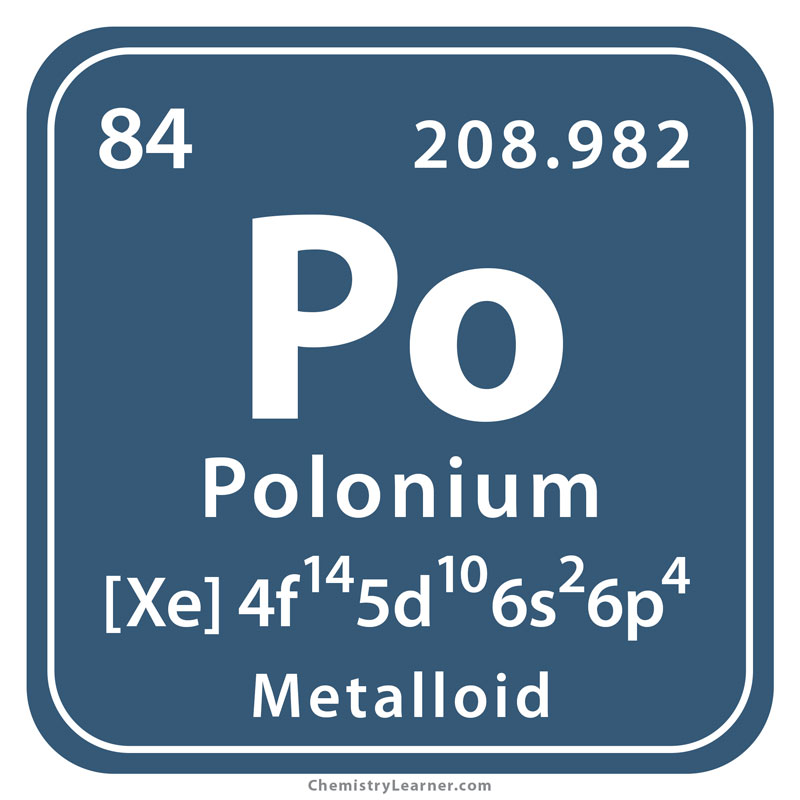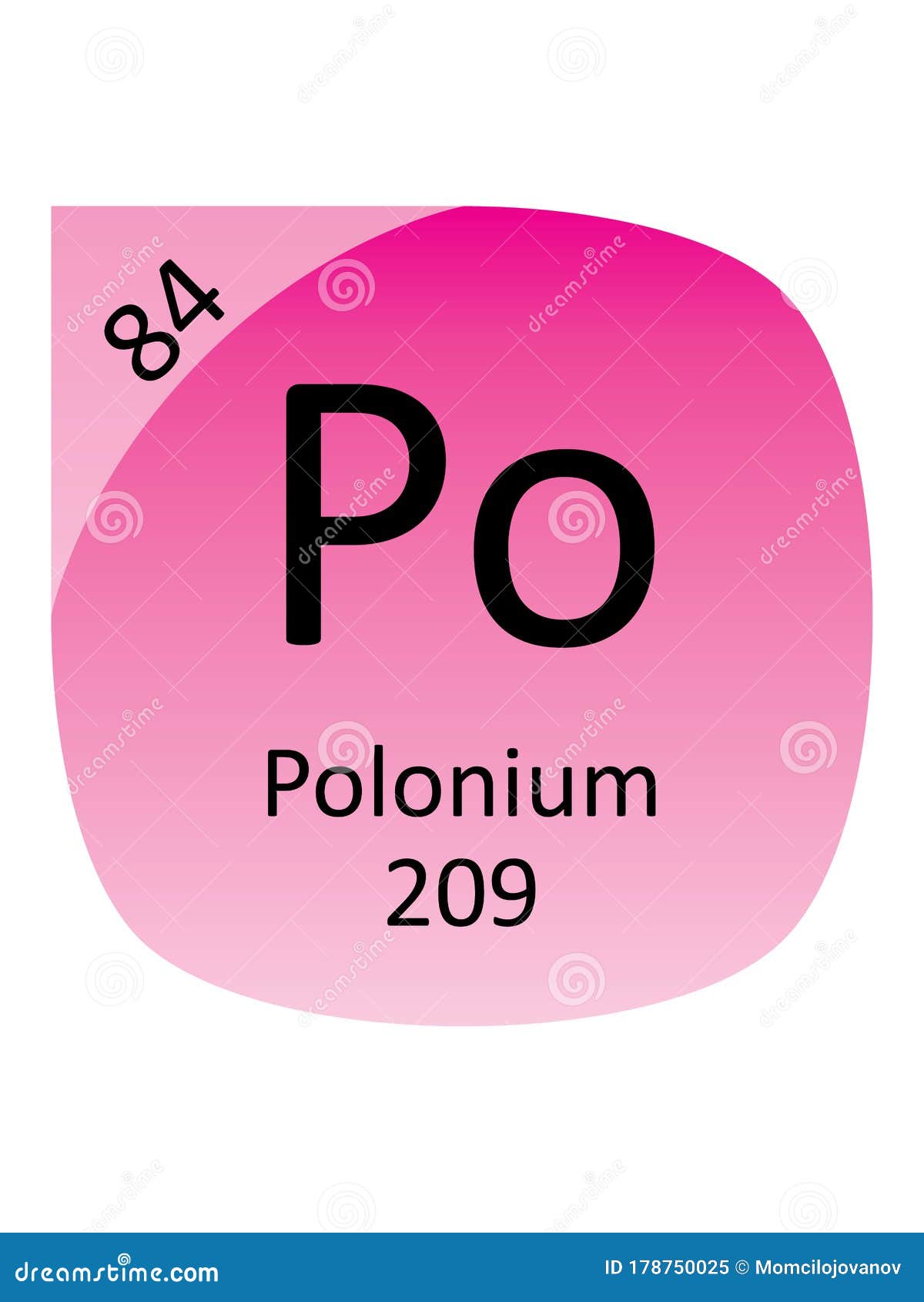Relative atomic mass The mass of an atom relative to that of carbon-12. This is approximately the sum of the number of protons and neutrons in the nucleus. Where more than one isotope exists, the value given is the abundance weighted average. Isotopes Atoms of the same element with different numbers of neutrons.
- What is Polonium? Polonium is the chemical element with symbol Po and atomic number 84 in the periodic table. This element was discovered by Marie Sklodowska Curie and Pierre Curie in 1898. Uses of Polonium. Polonium is an alpha-emitter, hence it is used in antistatic devices and for research purposes.
- Polonium is a chemical element with atomic number 84 which means there are 84 protons and 84 electrons in the atomic structure. The chemical symbol for Polonium is Po. Atomic Mass of Polonium Atomic mass of Polonium is 209 u.
POLONIUM (Po)
Who discovered Polonium?
Polonium was discovered in 1898 by Marie Curie while she was working in France. Polonium was the first element discovered by Curie and it was named after her birthplace, Poland.
Why was Polonium discovered?
Curie was attempting to to explain why pitchblende (a form of the mineral uraninite) from Joachimsthal, Bohemia was radioactive. Polonium was the cause, and it took several tons of pitchblende to yield very small amounts (10-6g per ton of ore).


How is Polonium obtained?
Small amounts can be found naturally in pitchblende, but it can also be produced through the nuclear irradiation of 209bismouth to obtain a product of 210polonium.
209Bi + 1n ----> 210Po + e-
How is Polonium used?
-- it is combined with beryllium to act as a neutron source
--used as an antistatic agent in textile mills
--on brushes to remove dust from film
--in nuclear batteries that provide thermoelectric power for space satellites
Interesting Polonium Facts..
--Gram for gram polonium is 2.5 x 1011 times as toxic as hydrocyanic acid.
--Polonium is found in tobacco.
--One mg of polonium-210 emits as much alpha radiation as 5 grams of radium, and gamma radiation causes a blue glow around it.
Polonium Data
Atomic Number: 84Atomic Mass:209 Oxidation States: 4, 2
Electron Configuration:
1s2 2s2p6 3s2p6d10 4s2p6d10f14 5s2p6d10 6s2p4
Electronegativity value:2
Isotopes: There are no naturally occurring isotopes of polonuium-209, but polonium-190 through polonium- 218 are possible to produce synthetically in laboratories (polonium-209 is naturally occurring). These 34 isotopes (polonium has the largest number of isotopes out of all the elements) are all radioactive. The most commonly used isotope is polonium-210.

Polonium 210 Atomic Number
Appearance:
How Many Neutrons Does Polonium
Color: Silver, gives off a blue glow State: Solid at STP
Physical Properties:
Melting Point: 527 K Boiling Point: 1235 K
Crystal Structure: Cubic Density: 9.33g/cm @ 300 K
The Cubic Crystalline Structure
The Element Polonium Atomic Number 84
Cost of Polonium: $3195/uCi at the Oak Ridge National Laboratory
References
Chemical properties of polonium - Health effects of polonium - Environmental effects of polonium

|
PoloniumPolonium is a radioactive, extremely rare semi-metal. It is reactive, silvery-gray, it dissolves in dilute acids, but it is only slightly soluble in alkalis. it is fairly volatile: about half of a sample of it will evaporate within 3 days (unless it is kept in a sealed container). Applications Nspro team driver download for windows 10. Polonium was once used in textile mills (to eliminate static charges) and by the manufacturers of photographic plates (in brushes to remove the accumulated dust). It is used as a source of alfa-radiation for research and, alloyed with beryllium it can act as a portable source of neutrons, which normally only access to a nuclear reactor can provide. Polonium in the environment Polonium is a very rare element in nature. it is found in uranium ores, but none extract it form these ores. Polonium is produced in about 100 g/year by bombarding bismuth with neutrons in a nuclear reactor. Health effects of poloniumPolonium is studied in a few nuclear research laboratories where its high radioactivity as an alpha-emitter requires special handling techniques and precautions. Polonium -210 is the only component of cigarette smoke that has produced cancer by itself in laboratory animals by inhalation - tumors appeared already at a polonium level five times lower than those of a normal heavy smoker. Lung cancer rates among men kept climbing from a rarity in 1930 (4/100,000 per year) to the No. 1 cancer killer in 1980 (72/100,000) in spite of an almost 20 percent reduction in smoking. But during the same period, the level of polonium -210 in American tobacco had tripled. This coincided with the increase in the use of phosphate fertilizers by tobacco growers - calcium phosphate ore accumulates uranium and slowly releases radon gas. As radon decays, its electrically charged daughter products attach themselves to dust particles, which adhere to the sticky hairs on the underside of tobacco leaves. This leaves a deposit of radioactive polonium and lead on the leaves. Then, the intense localized heat in the burning tip of a cigarette volatilizes the radioactive metals. While cigarette filters can trap chemical carcinogens, they are ineffective against radioactive vapors. The lungs of a chronic smoker end up with a radioactive lining in a concentration much higher than from residential radon. These particles emit radiation. Smoking two packs of cigarettes a day imparts a radiation dose by alpha particles of about 1,300 millirem per year. For comparison, the annual radiation dose to the average American from inhaled radon is 200 mrem. However, the radiation dose at the radon 'action level' of 4 pCi/L is roughly equivalent to smoking 10 cigarettes a day. In addition, polunium-210 is soluble and is circulated through the body to every tissue and cell in levels much higher than from residential radon. The proof is that it can be found in the blood and urine of smokers. The circulating polonium -210 causes genetic damage and early death from diseases reminiscent of early radiological pioneers: liver and bladder cancer, stomach ulcer, leukemia, cirrhosis of liver, and cardiovascular diseases. The Surgeon General C. Everett Koop stated that radioactivity, rather than tar, accounts for at least 90% of all smoking-related lung cancers. The Center for Disease Control concluded 'Americans are exposed to far more radiation from tobacco smoke than from any other source.' Cigarette smoking accounts for 30% of all cancer deaths. Only poor diet rivals tobacco smoke as a cause of cancer in the U.S., causing a comparable number of fatalities each year. However, the National Cancer Institute, with an annual budget of $500 million, has no active funding for research of radiation from smoking or residential radon as a cause of lung cancer, presumably, to protect the public from undue fears of radiation. Environmental effects of poloniumThe environmental and biochemical forces which may tend to reconcentrate these toxic materials in living cells are not well known. Although polonium occurs naturally, it has become much more available for entering into water, food, living cells and tissue since the mining boom which began shortly after the Second World War. Back to chart periodic elements. |
Polonium Atomic Mass Number

More from 'Elements'
Atomic Number For Polonium
Lenntech (European Head Office)
Distributieweg 3
2645 EG Delfgauw
The Netherlands
Phone: +31 152 610 900
fax: +31 152 616 289
e-mail: info@lenntech.com
Lenntech USA LLC (Americas)
5975 Sunset Drive
South Miami, FL 33143
USA
Phone: +1 877 453 8095
e-mail: info@lenntech.com
Lenntech DMCC (Middle East)
Level 5 - OFFICE #8-One JLT Tower
Jumeirah Lake Towers
Dubai - U.A.E.
Phone: +971 4 429 5853
e-mail: info@lenntech.com
Copyright © 1998-2021 Lenntech B.V. All rights reserved
